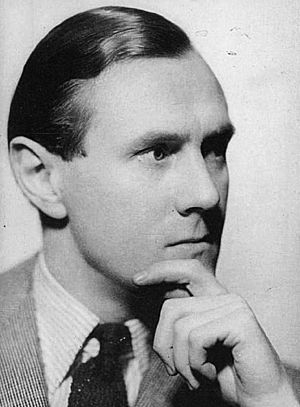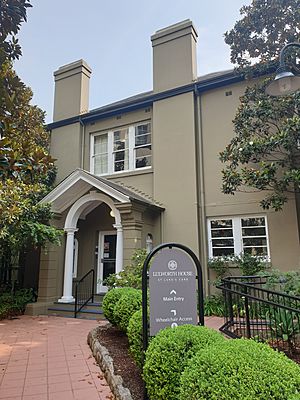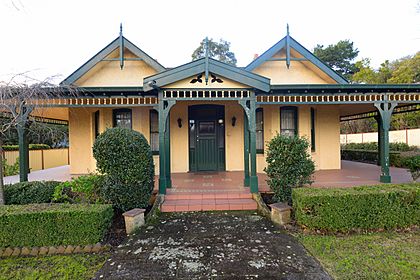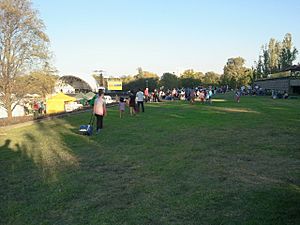Patrick White facts for kids
Quick facts for kids
Patrick White
|
|
|---|---|

White, c. 1940s
|
|
| Born | Patrick Victor Martindale White 28 May 1912 Knightsbridge, London, UK |
| Died | 30 September 1990 (aged 78) Sydney |
| Language | English |
| Nationality | Australian |
| Education |
|
| Alma mater | King's College, Cambridge |
| Period | 1935–1987 |
| Notable works | Selected works |
| Notable awards |
|
| Partner | Manoly Lascaris (1941–1990) |
| Military career | |
| Allegiance | |
| Service/ |
|
| Years of service | 1940–1945 |
| Battles/wars | World War II |
Patrick Victor Martindale White (born May 28, 1912 – died September 30, 1990) was a famous Australian writer. He was born in Britain but moved to Australia as a baby. He wrote many books, short stories, and plays between 1935 and 1987.
White's stories often used humor and vivid descriptions. They also explored characters' thoughts and feelings deeply. In 1973, he won the Nobel Prize in Literature. This award recognized his "epic and psychological narrative art which has introduced a new continent into literature." He is the only Australian to have won this prestigious prize. White also received the first-ever Miles Franklin Award, a top Australian literary award.
Contents
Early Life and School Years
Patrick White was born in Knightsbridge, London, on May 28, 1912. His parents, Victor and Ruth White, were both Australians. When he was six months old, his family moved back to Sydney, Australia. As a young child, he lived in a flat with his sister, a nanny, and a maid. His parents lived in a flat next door.
In 1916, his family moved to a house in Elizabeth Bay. Years later, this house became a nursing home. Famous people like Gough Whitlam and White's lifelong partner, Manoly Lascaris, lived there.
Childhood Health Challenges
When Patrick was four, he developed asthma. This was a serious health issue that had also affected his grandfather. Because of his fragile health, he couldn't join in many typical childhood activities.
A Love for Theatre
From a young age, White loved the theatre. His mother took him to see plays, like The Merchant of Venice, when he was only six. This love for performance showed at home. He would put on shows in the garden and dance for his mother's friends.
Boarding School Experiences
At age five, he started kindergarten in Woollahra, Sydney. When he was ten, White was sent to Tudor House School. This was a boarding school in Moss Vale, chosen to help with his asthma. It took him some time to get used to being around other children.
At boarding school, he began writing plays. Even then, his plays explored grown-up ideas. In 1924, his school faced money problems. The headmaster suggested he go to a public school in England, which his parents agreed to.

White found it hard to adjust to his new school, Cheltenham College, in England. He later called it "a four-year prison sentence." He became quiet and had only a few friends. Sometimes, he went on holidays with his parents in Europe, but they remained distant. However, he spent time with his cousin Jack Withycombe. Jack's daughter, Elizabeth Withycombe, helped him when he wrote his first book of poems, Thirteen Poems, between 1927 and 1929.
While at school in London, White made a close friend, Ronald Waterall. They shared many interests. They would go to London shows together and try to catch a glimpse of their favorite stars. When Waterall left school, White felt alone again. He asked his parents if he could leave school to become an actor. His parents agreed to let him finish early if he came back to Australia to work on a farm. They hoped farm work would make him less interested in art.
White spent two years working as a stockman at Bolaro. This was a large farm near Adaminaby, in southeastern Australia. He learned to respect the land, and his health improved. But it was clear he was not suited for farm life.
Adventures and Early Writing Career
From 1932 to 1935, White lived in England. He studied French and German literature at King's College, Cambridge University.
In 1934, White published a book of poems called The Ploughman and Other Poems. His parents helped fund the publishing of this book. He also wrote a play, Bread and Butter Women. An amateur group in Sydney later performed it. After finishing his degree in 1935, White moved to London. He lived in an area popular with artists. Here, he wrote several new works and improved an earlier novel, Happy Valley.
In 1937, White's father passed away. White inherited money, which allowed him to write full-time. Happy Valley was published and well-received in London, but not in Australia. He started another novel, Nightside, but stopped writing it after negative feedback. He later said he regretted this decision.
Friendships and Influences
In 1936, White met the painter Roy De Maistre. De Maistre was 18 years older and became a very important person in White's life. They remained close friends. White said De Maistre became "what I most needed, an intellectual and aesthetic mentor." They both felt like outsiders in their families. They also shared an interest in Christian symbols and Bible themes in their art.
White dedicated his first novel, Happy Valley, to De Maistre. De Maistre's painting, Figure in a Garden (The Aunt), was used on the cover of White's book The Aunt's Story in 1947. White bought many of De Maistre's paintings. In 1974, he gave them all to the Art Gallery of New South Wales.
World War II and a New Home
Towards the end of the 1930s, White traveled in the United States. He visited places like Cape Cod and New York City. These were artistic centers at the time. There, he wrote The Living and the Dead. When World War II began, he returned to London. He joined the British Royal Air Force as an intelligence officer. He served in Egypt, Palestine, and Greece.
During his time in the Middle East, he met Manoly Lascaris, a Greek army officer. Manoly became his lifelong partner. After the war, in 1948, White and Lascaris moved to a small farm. It was in Castle Hill, which was then a semi-rural area near Sydney. White named their home "The Dogwoods." They lived there for 18 years. They sold flowers, vegetables, milk, and even puppies. After White's mother died in 1963, they moved to a larger house called Highbury in Centennial Park. They lived there for the rest of their lives.
A Growing Writing Career
After the war, White's fame as a writer grew. His books The Aunt's Story and The Tree of Man were published in the United States and then the United Kingdom. The Tree of Man received great reviews in the US. However, in Australia, it was criticized. White wondered if he should keep writing because his books were often disliked in Australia. Some critics even called them "un-Australian."
But he decided to continue. His next novel, Voss, finally brought him success in Australia. It won the first-ever Miles Franklin Literary Award.
In 1961, White published Riders in the Chariot. This book became a bestseller and won him a second Miles Franklin Award. In 1963, White and Lascaris sold their Castle Hill house. Many of White's books from the 1960s featured a fictional town called Sarsaparilla. This included his short story collection, The Burnt Ones, and the play, The Season at Sarsaparilla.
White was now known as one of the world's great authors. But he remained a private person. He avoided interviews and public appearances. Still, his circle of friends grew.
Art and Artists
In 1968, White wrote The Vivisector. This book was a powerful story about an artist. Many people thought it was based on Sydney painter John Passmore or White's friend, Sidney Nolan. But White said these connections were not true.
Patrick White loved collecting art. When he was young, he was very impressed by his friends Roy De Maistre and Francis Bacon. He later said he wished he had been an artist himself. By the mid-1960s, he also started supporting many young and less famous artists. A portrait of White by Louis Kahan won the 1962 Archibald Prize. White was also friends with Brett Whiteley, a young Australian painter, in the 1970s. This friendship ended when White felt Whiteley was dishonest about selling his paintings.
Declining Awards and Political Views
White decided not to accept any more prizes for his work. He turned down a $10,000 Britannia Award and another Miles Franklin Award. He also became a strong opponent of literary censorship. He joined other public figures in speaking out against Australia's involvement in the Vietnam War.
His name was sometimes mentioned as a possible winner for the Nobel Prize in Literature. But in 1971, after losing to Aleksandr Solzhenitsyn, he wrote to a friend: "That Nobel Prize! I hope I never hear it mentioned again. I certainly don't want it." He felt it would disrupt his life too much.

However, in 1973, White did accept the Nobel Prize. He won it "for an epic and psychological narrative art, which has introduced a new continent into literature." White asked his friend, the artist Nolan, to travel to Stockholm to accept the prize for him. The award greatly boosted his career. His publisher printed twice as many copies of his book The Eye of the Storm. They also gave him a larger payment for his next novel.
White used the prize money to create a trust. This trust funds the Patrick White Award. It is given every year to established writers who have not received much public recognition. The Australian House of Representatives invited him to sit on the floor of the House to honor his achievement. White declined, saying he was not comfortable with such public attention. The last time such an invitation was given was in 1928, to the famous aviator Bert Hinkler.
White was named Australian of the Year for 1974. But in his typical rebellious way, his acceptance speech encouraged Australians to think about the state of their country. Privately, he was not very excited about the award. He wrote in a letter: "Something terrible happened to me last week. There is an organisation which chooses an Australian of the Year... This year I was picked on as they had run through all the swimmers, tennis players, yachtsmen."
Later Years and Legacy
White and his partner, Manoly Lascaris, often hosted dinner parties at their home, Highbury. This house was in a green, wealthy part of Sydney. White was a friendly host but could easily fall out with friends.
White supported the Liberal Party of Australia for a time. But after Gough Whitlam's Labor government was elected, and especially after the 1975 Australian constitutional crisis, he became strongly against the Royal family. He even made a rare appearance on national television to share his views. White also publicly admired historian Manning Clark, satirist Barry Humphries, and union leader Jack Mundey.
Health Challenges and Final Works
During the 1970s, White's health began to decline. He had dental problems, his eyesight was failing, and he had chronic lung issues. During this time, he became more openly political. He spoke publicly about current events.
He was among the first group of people to be made Companion of the Order of Australia in 1975. But he resigned in June 1976. This was in protest against the dismissal of the Whitlam government in November 1975. In 1979, his novel The Twyborn Affair was nominated for the Booker Prize. But White asked for it to be removed so younger writers would have a chance to win.
Director Jim Sharman became friends with White. Sharman's theatrical style inspired White to write new plays. One notable play was Big Toys, which made fun of posh Sydney society. A few years later, Sharman asked White if he could make a film of The Night the Prowler. White agreed and wrote the movie script.
In 1981, White published his autobiography, Flaws in the Glass: a self-portrait. In this book, he wrote about things he had not discussed much publicly. These included his dislike of Australia's "subservient" attitude towards Britain and the Royal family. He also wrote about feeling distant from his mother. On Palm Sunday, 1982, White spoke to a crowd of 30,000 people. He called for a ban on uranium mining and for the destruction of nuclear weapons.
In 1986, White released his last novel, Memoirs of Many in One. It was published under the pen name "Alex Xenophon Demirjian Gray," with White listed as the editor. In the same year, Voss was turned into an opera. White refused to see it when it was first performed because Queen Elizabeth II had been invited. He chose to see it later in Sydney. In 1987, White wrote Three Uneasy Pieces. This book included his thoughts on aging and society's efforts to achieve perfect beauty. When David Marr finished his biography of White in July 1990, White spent nine days reviewing the details with him.
Patrick White passed away in Sydney on September 30, 1990.
Lasting Impact
In 2009, The Sydney Theatre Company performed White's play The Season at Sarsaparilla. In 2010, White's novel The Vivisector was nominated for the Lost Man Booker Prize for 1970.
In 2011, a film based on White's novel The Eye of the Storm was released. This was the first time a White novel was made into a movie. It was fitting, as this novel played a key role in him winning the Nobel Prize.
List of Works
|
Novels
Short Story Collections
|
Poetry
Plays
Screenplay
Autobiography
|
Honors and Awards
In 1970, White was offered a knighthood but turned it down.
White was one of the first six people to be appointed a Companion of the Order of Australia (AC) in 1975. However, he resigned from the order in 1976. This was a protest against the dismissal of the Whitlam government by Sir John Kerr in November 1975.
Commemoration
Patrick White is remembered through the Patrick White Lawns. These lawns are next to the National Library of Australia in Canberra. They are a popular spot for concerts and other public events.
Images for kids
-
Lulworth, White's childhood home in Elizabeth Bay, Sydney
-
Patrick White's home Highbury, in Centennial Park, Sydney
See also
 In Spanish: Patrick White para niños
In Spanish: Patrick White para niños








